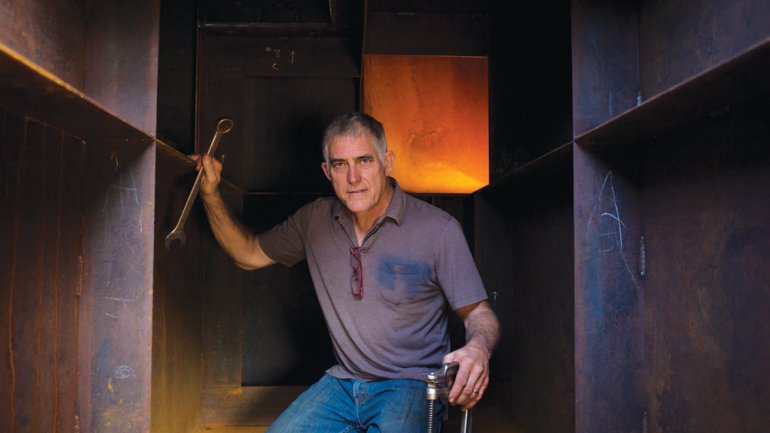Grand Scale
Grand Scale
Hoss Haley works big. We’re talking huge, as in 40 feet high and wide – the dimensions of his latest public art project, a 25-ton outdoor steel sculpture commissioned by the city of Charlotte, North Carolina, for its airport. It’s his largest piece to date, and even he finds it a bit overwhelming.
“There’s a lot going on there. I have to say it’s the most I’ve taken on,” Haley says of Old Growth, a treelike structure of interconnected steel boxes meant to suggest the majesty of a giant oak. Watching it take shape as he and his crew built it over the summer, he couldn’t help feeling a sense of wonder. “I know the piece intimately, but at the same time, when I’m in its presence, it’s a complete mystery to me.”
It takes serious control to do what Haley does, adapting industrial machines and methods to fabricate steel and bronze into huge coils, spheres, curves, ripples, and geometric compositions. The challenge is finding ways to stay loose creatively – to respond to the material, let a design reveal itself, “participate in the work and yet allow for it to have a life of its own.”
Born in 1961, Mark Haley was “a chubby little kid with a big cowboy hat” when an uncle nicknamed him after the character on the TV Western Bonanza, and it stuck. He grew up in Kansas on his family’s wheat and cattle farm. Looking back, he sees in that landscape the genesis of his monumental approach.
“Everything out there is either macro or micro. I remember working the fields and seeing grain elevators coming off the flat plain, a sky so vast you could see the curve of the Earth. Then stopping and watching a bug crawl across the ground. In that environment there is no middle. It’s all giant or tiny.” Like his work today: He does tabletopsize studies along with huge pieces but feels his ideas don’t translate well on a scale in between.
He was always comfortable in the farm shop, around machinery. “My father was a bit of an inventor, always dreaming up the better mousetrap, the better plow. I just kind of took to it,” he says. For “some peculiar reason,” he got interested in art, too, and played around with sculpture. “It was an internal yearning, I guess.”
When he was a teenager, the local newspaper wanted a sculpture outside its office. “Someone knew of this young kid out north of town that messed around with such things,” says Haley, who was hired to design and build a 32-foot stalk of wheat out of Cor-ten steel. “The night after I installed it, the winds kicked up to 70 miles an hour,” he recalls. “I barely slept. I went out there the next morning, and the wind was still howling. And my sculpture was just sitting there, waving in the wind, like a perfect little piece of wheat.” It’s still there.
Other commissions followed, and after high school Haley decided to pursue creative metalwork. “I was the one who was going to stay on the farm. But I knew [art] was where I needed to go.” He spent six years working for renowned blacksmith Tom Joyce in Santa Fe before striking out on his own. By the late 1990s he was an artist in residence at Penland School of Crafts in North Carolina; in 2000 he moved to nearby Asheville, where he made small, architecturally inspired metal vessel forms. They sold successfully in galleries, yet he felt restless.
“I loved the craft, loved pounding on hot metal,” he says. “But it wasn’t serving my creative side, my impulses, thoughts, ideas. And my ideas were getting bigger.”
One day he watched two men with a crane build a golf-ballshaped water tower by lifting plates one by one and welding them into place. He had an epiphany: “I thought, really, the only limitation on scale is how many pieces. I could work infinitely large with that mindset. So I set about finding a new way of working.”
Haley’s resolve became reality. Today, his studio in Asheville is equipped with tools he custom-built from scratch, including a 100-ton hydraulic press and his own small crane (he’ll hire a pro for heavier lifts), plus a couple of “really solid” employees. When he’s not in the shop or installing a piece on site, he’s often at Penland, an hour away, where his wife, artist Leslie Walker Noell, is director of programs. (They met there and now have a son, 8.)
Several times a week, he visits a local scrapyard for raw material. After the economic crisis of 2008, he saw the rich pickings of structural steel remnants and other industry castoffs disappear almost overnight, leaving behind an endless supply of washers, dryers, and other consumer waste. With no more I-beams to be had, he started playing with the thin white appliance metal, creating a series of works that resemble big balls of wadded-up, tossed-out paper – a comment on consumerism and disposability. Such forays, like the computer-driven drawing machine he built a few years back, sustain Haley’s big vision. “
So much of what I do comes from limitations,” he reflects. “I think that’s why I have a certain comfort level with public art, because public art is nothing but limitations” – safety, physics, bureaucracy, sometimes a theme. “I’m figuring out what the parameters are and then seeing how hard I can push against them.” Experience has taught him to keep it simple – to not get bogged down in technique, important as that is.
“I’m always looking for the direct path. I think it requires getting out of your own way. Not letting the craft get in front of you. Giving up enough so that you can just be on for the ride.”
Joyce Lovelace is American Craft’s contributing editor.

